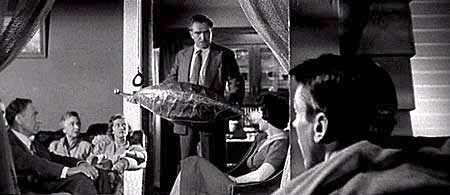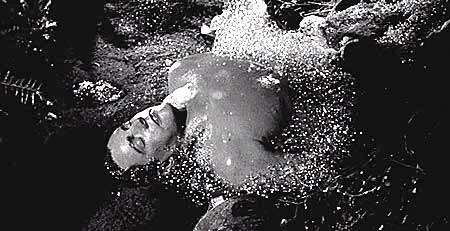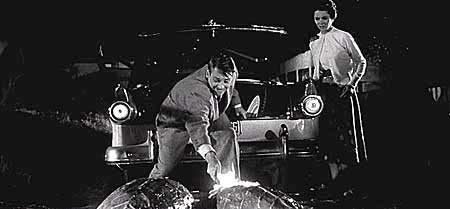In Body Snatchers, the pod people, who, like McCarthy and the other red-baiters, look like typical, fine upstanding Americans, search out rebels like Miles who refuse to conform to what has been newly defined as the "American Way"—just as McCarthy and HUAC destroyed the lives of those who refused to knuckle under to their directives. The mob hysteria, the sense of paranoia, the fascist police, the witch hunt atmosphere of the picture certainly mirrors the ills of McCarthy’s America.
The changes brought about by World War II were swift, and they profoundly disturbed people’s understanding of life—especially now that humanity was living in the shadow of the atomic bomb.
Before the bomb and subsequent scientific advances, western humanity knew and accepted the inevitability of death. Seen and experienced by both men and women, young and old, death occupied the realm of the immediate. It was utterly real and visible.
The bomb’s dehumanizing influence, however, made death invisible, abstract and threatening. While the older generation may have viewed the atomic bomb as the pinnacle of human achievement and worldwide peace, the succeeding generation realized that it might possibly be an insurmountable barrier to the future. Suddenly, death was no longer a wispy, terrifying phantom that chose its victims at random but instead became a calculated, mechanical weapon that obliterated humanity en masse.
Amidst the threat of atomic death from on high, the western world was embroiled in the Cold War. Although both the American and Soviet governments were painting a horrendous picture of a possible hot war, the so-called Cold War was, for all intents and purposes, a political fabrication. In fact, mutual threats and brinkmanship supported a relatively stable international system, symbolized by the 1963 installation of the telephone "hot line" linking the White House to the Kremlin.
The Cold War scenario, of course, led to the "Red scare" and the American hysteria over the danger of Communist subversion in the United States. This hysteria culminated in the hearings before the House Committee on Un-American Activities, where hundreds were called to testify about their so-called Communist affiliations. The Committee was led by the then-junior Republican senator from Wisconsin, Joseph McCarthy, who specialized in sensational, unsubstantiated accusations about Communist infiltration of the American government. As a result of the hearings, many lost their jobs and families and some even committed suicide.
Much like the mass hysteria that has spread over the United States since the terrorist attacks on the World Trade Center and the Pentagon, many McCarthy-era government officials were calling for and enacting extreme measures to combat a perceived threat. And the real question at the time—as it is for the present—was whether people would retain their basic freedoms and avoid the dredge of conformity that threatens our very humanity.
Various films attempted to covertly address the paranoia sweeping the country during the 1950s. One in particular, Don Siegel’s 1956 classic Invasion of the Body Snatchers, captured the ideology and politics of this time period perfectly.

Body Snatchers is set in the small California town of Santa Mira, which is infiltrated by pods from outer space that replicate and take the place of humans. Miles Bennell (Kevin McCarthy), the main character in the film, is a local doctor who resists the invaders and their attempts to erase humanity from the face of the earth. Body Snatchers—now available on DVD and digitally remastered—brought respectability to the science fiction genre that emerged in the post-war era, a genre that was exploding on screens around the country, partly due to the numerous post-Roswell UFO sightings. Filmed with only seven days of rehearsal and twenty-three days of actual shooting, Body Snatchers, as such, is still considered the greatest of all the horror and science fiction classics of the 1950s. It continues to fascinate modern filmmakers, having been remade twice (1978 and 1994), and has served as a model for a myriad of films and television shows. And Carmen Dragon’s film score has influenced filmmakers and television directors alike. In fact, Dragon’s haunting piano chords can be heard in such television shows as The X-Files and Buffy: The Vampire Slayer.
Perhaps the effectiveness of Body Snatchers can be explained by its fine ensemble cast—Kevin McCarthy, Dana Wynter, Carolyn Jones, King Donovan and Sam Peckinpah (also the dialogue coach), among others (all essentially unknown actors at the time). Or perhaps it was the crafty manner in which director Siegel avoided the use of special effects. Or maybe it was the strong story provided by Jack Finney and Daniel Mainwaring’s screenplay. Whatever the reason, Body Snatchers—an 80-minute trip loaded with information—has become one of the most analyzed films of its kind. Film students today still attempt to untangle the film’s metaphors, claiming that the film can be seen as a symbol for AIDS and other contagious and venereal diseases or that its power stems from a lingering fear of the mysteriousness of nature. Despite extensive critical analysis and faulty proposed philosophies concerning the film’s meaning, reviewers still strive to understand Siegel, Finney and Mainwaring’s deeper message.
Body Snatchers invokes at least a double reading. It was both a mirror of a particular moment in history and a compass indicating the symptoms of a growing societal illness. Following World War II, the atomic bomb and the Korean War, Americans were confused and neurotically preoccupied with international political events—much like they are today. Siegel’s film addressed the dehumanization of individuals—a sensitive subject in an age filled with tales of political brainwashing of American soldiers by the Koreans—and the horrifying possibility which arose in the 1950s where humanity could become infused as part of the machine.

The film’s ideology is focused well to the left of center, despite the fact that Jack Finney’s story is centrist in nature. It was Daniel Mainwaring who followed out the pessimistic strain underlying Finney’s paranoid fantasy. As Al LaValley writes in Invasion of the Body Snatchers, "Mainwaring’s despair is the despair of a onetime strong leftist over the America of the fifties." Indeed, the House Un-American Activities Committee had decimated Hollywood and the Hollywood Ten had gone to jail. A blacklist was in force, and everyone was being asked to sign a pod-like loyalty oath to prove they were "good" Americans and not Commie subversives. A chilling pod-like uniformity reigned in Hollywood. LaValley notes, "Risk was no longer acceptable; perhaps serious social subjects could be approached only in disguised form through the crime and science fiction genres."
It was Mainwaring who added Miles’ important speech, central to the film and without antecedent in the book. While hiding from the aliens, Miles says to Becky (Dana Wynter), "In my practice I see how people have allowed their humanity to drain away…only it happens slowly instead of all at once. They didn’t seem to mind…. All of us, a little bit. We harden our hearts…grow callous…only when we have to fight to stay human do we realize how precious it is."
Thus, for Mainwaring there was no overt anti-Communist message in the film. To Mainwaring, we are the villains. And Communism was a scapegoat, an imaginary villain reflecting the fears and tensions of the Right. "If the pods in Invasion seem to incarnate the popular image of a communist totalitarian state," LaValley points out, "it is only because the government-dominated, bureaucratic, and conformist fifties was itself creating an America like this picture of Soviet Russia."
The only resistance to the perceived repression was an embattled individualism, something Siegel could identify with. He, too, saw hope in the defiant individual. However, unlike Mainwaring, Siegel saw the conflict between society and the individual as a perpetual one—more a metaphysical battle than a political one. And the villains were not so much on the other side of the world, as all around us. The real enemy was, therefore, totalitarian conformity. And resistance must be against all kinds of conformity, no matter the shape, size or color of the package it comes in. If not, the enemy lulls us into giving up our individuality, not merely taking up an alien cause.
Siegel, however, understood the irrational fears of the day and manifested conspiratorial paranoia himself. In fact, he changed the ending of Finney’s novel to intensify the paranoiac aspect. Rather than follow Finney’s ending that depicted pods rising from a field and away from the earth, Siegel showed a lone, seemingly madman in a rage. Where Finney provided hope, Siegel presented conspiracy and destitution.
Why were viewers so attracted to Siegel’s pessimistic message? David J. Skal in The Monster Show: A Cultural History of Horror notes that the film, which pretended to scare viewers, actually comforted them. Audiences found an understandable world reassuring, even if such understanding was only a monstrous plot or cover-up. Joseph McCarthy and his anti-Communist banter used the same rationale.
No matter the criteria of those who made the film, many saw Body Snatchers as presenting an overt Communist metaphor: the alien pod people perfectly fit McCarthy’s profile of Russians and, not coincidentally, American schoolteachers. The Soviets were considered ice cold, outwardly peaceful but very authoritarian and emotionless. Many Americans even considered Russians a different species who, because of their disbelief in God, were soulless and wanted to destroy Americans or turn them into Communist clones. The film’s villains and the public’s view of the Communists presented limitless parallels. As Danny Peary recognizes in Cult Movies:
The unraveling of the pod conspiracy has the flavor of an FBI exposé. The pod people represent a completely regimented society. Metaphorically, they are all alike as "two peas in a pod" because they have been sapped of their emotional individuality. The vegetarian metaphor literalizes Red-scare rhetoric of the "growth" of Communism as well as the idea that revolutions are made by planting seeds. There is a scene in which the pod people are assembled in the town square, where a loud speaker reads off the day’s orders; it is the quintessential fifties image of socialism. And, of course, the simile that without freedom of thought people are…vegetables is a central theme of the narrative.

While Peary’s interpretation of the movie is the most widely held, an anti-McCarthian message also emerges that presents the fascistic pod people as the American majority: the central government, law enforcement agencies and communication regulators that dictate America’s political line, including Joe McCarthy. According to Peary, government officials, not the Communists, posed the true threat.
Body Snatchers may also be interpreted as anti-scientific, reflecting the fears of a particular decade. During America’s early space exploration, many Americans feared space would invade the earth and viewed the movie as a warning of the dangers of science and inventions like the hydrogen bomb. People realized scientific advances often negatively influenced the culture. Miles, at one point in the film, says, "So much has been discovered the past few years. They may be the result of atomic radiation or weird alien organisms."
In this general category of science, a fear of psychiatry should not be excluded. The psychiatrist-alien in the film pronounces the death of God by banishing the idea of the individual soul.
While these various interpretations may be compelling, they seldom mention the ideas of the book’s author, Jack Finney, who claimed that he did not read, write or even like science fiction. He was interested instead in the ability of technology, modernization and fragmentation to disenfranchise people and make them lose their ability to act human.
Finney was concerned that humans had ceased being the masters of their own inventions and that, even more fundamentally, they had lost the ability to master anything at all. He saw traditional morals and values as victims of a "rush to modernize, bureaucratize, streamline and cellophane-wrap." Finney’s traditionalism is easily mistaken for anti-Communist rhetoric since McCarthyites used conservatism to battle the evils they felt were destroying America (such as desegregation, Social Security, obscenity, progressive education and liberal Protestantism). Ironically, intellectuals ultimately rejected traditionalism because of its association with McCarthy. Finney attempted to answer the question of survival in a post-war world and believed that true humanness required one to "assert [his] individuality to the fullest, express [his] real feelings, and embrace the human values of pride, dignity, friendship, and love more strongly."
While Siegel admitted that his films showed the conflict between individuals and varied forms of mindless authority, he denied an anti-Communist motive. In defense of Body Snatchers, he stated, "I think the world is populated by pods and I wanted to show them." He also believed that humans had lost much of their sensitivity because of the advance in military weaponry and the atrocities of recent wars. Dr. Bassett, the film’s unsympathetic doctor, exemplifies an individual who acts like a pod. Siegel explained the pod’s representation:
People are pods. Many of my associates are certainly pods. They have no feelings. They exist, breathe, sleep. To be a pod means that you have no passion, no anger, the spark has left you…of course, there’s a very strong case for being a pod. These pods, who get rid of pain, ill-health and mental disturbances are, in a sense, doing good. It happens to leave you in a very dull world but that, by the way, is the world that most of us live in. It’s the same as people who welcome going into the army or prison. There’s regimentation, a lack of having to make up your mind, face decisions…. People are becoming vegetables. I don’t know what the answer is except an awareness of it. That’s what makes a picture like Invasion of the Body Snatchers important.
Sources
John Brosnan, Future Tense: The Cinema of Science Fiction (St. Martin’s Press, 1978)
Al LaValley, editor, Invasion of the Body Snatchers (Rutger’s University Press, 1989)
Kevin McCarthy and Ed Gorman, "They’re Here…" Invasion of the Body Snatchers: A Tribute (Berkeley Boulevard Books, 2000)
Danny Peary, Cult Movies (Delta Books, 1981)
Richard Gid Powers, "Introduction" in Jack Finney, The Body Snatchers (Gregg Press, 1976)
Per Schelde, Androids, Humanoids, and Other Science Fiction Monsters (New York University Press, 1993)
David J. Skal, The Monster Show: A Cultural History of Horror (Penguin Books, 1994)
Kenneth Von Gunden and Stuart H. Stock, Twenty All-Time Great Science Fiction Films (Arlington House, 1982)
Tom Weaver, I Was A Monster Movie Maker (McFarland, 2001)